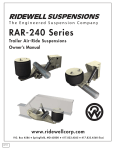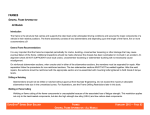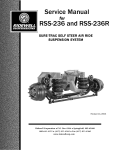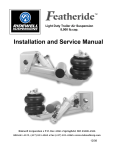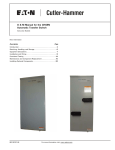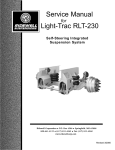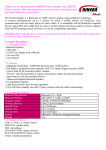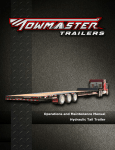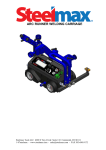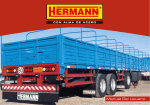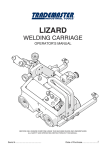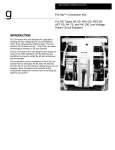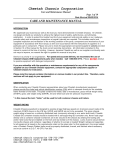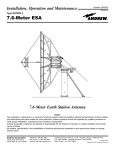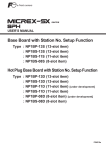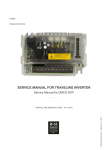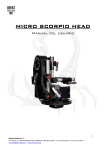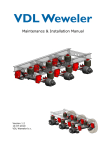Download Service Manual for RAR
Transcript
0810 CONTENTS Pre-Installation Notes...............................................................................................Pg 2 Configuration............................................................................................................Pg 3 Installation - General.................................................................................................Pg 4 Installation - Axle to Suspension..............................................................................Pg 4 Installation - Suspension to Frame............................................................................Pg 4 Axle Alignment..........................................................................................................Pg 5 Torque Requirements................................................................................................Pg 6 Height Control System Installation...........................................................................Pg 6 Bushing Check Procedure.........................................................................................Pg 6 Bushing Replacement Procedure........................................................................Pg 7 - 8 Maintenance Schedule..............................................................................................Pg 8 Weld Process............................................................................................................Pg 9 Parts Illustration.......................................................................................................Pg 10 - 13 Warranty..........................................................................................................................Pg 14 SUSPENSION IDENTIFICATION: Ridewell Suspensions are identified by a metal tag attached to the left-hand hanger that indicates part number, revision level, and serial number. PARTS: For optimum suspension performance, order only Ridewell parts. Replacement parts for Model RAR-240 are shown on pages 10-13 of this manual. SALES, SERVICE & WARRANTY: If you need assistance regarding this product, please contact us and we will be glad to help you. Mailing Address Ridewell Corporation P.O. Box 4586 Springfield, MO 65808 Shipping Address Ridewell Corporation 3715 E. Farm Rd. 94 Springfield, MO 65803 Phones, Fax, Email 800-641-4122, (417) 833-4565 (417) 833-4560, fax [email protected] Pre-Installation Notes 1. Suspensions are designed to operate within specific parameters. Operating the suspension outside the design parameters may result in improper performance, damaged equipment and voiding of the warranty. 2. The total operating capacity of a suspension / running gear system is determined by the component with the lowest load rating. Please consult with the manufacturers of axles, brakes, tires and wheels to determine the maximum suspension system capacity. 3. The installer is responsible for ensuring that air volume requirements are met. Consult Federal Motor Vehicle Safety Standards (FMVSS) 121 for more information. 4. Welding or altering suspension components is not permitted except where explicitly stated by Ridewell Corporation. 2 Configuration The Ridewell model RAR-240 suspension is designed to accommodate a range of ride heights for each specific model and can be used on a variety of axle types for various applications. The following characteristics are commonly referenced for set-up of the suspension: 1. Ride Height (also called Mounting Height) - The distance from the bottom of the trailer frame to the centerline of the axle. Ride height is related to frame height (the distance from the bottom of the frame to the ground) by the following formula: Ride Height = Frame Height - Loaded Tire Radius The loaded tire radius for common tire sizes can be found in Chart 1. 2. Beam Centers - The centerline-to-centerline distance from one axle seat to the other. For the RAR-240, this is also the same as the centerline-to-centerline distance from one hanger to the other. The RAR-240 is designed to fit up onto standard I-beam trailer frames at beam centers that correspond to standard axle track widths as shown below with standard wheel-end equipment. Installation at wider beam centers will reduce suspension clearances; installation at narrower beam centers will de-rate the axle beam capacity per the axle manufacturer’s specifications. For non-standard beam centers, frames, frame centers, axle track or wheel-end equipment, the installer is responsible for verifying clearances, axle capacity, proper fit-up, and any additional required support structure. Standard Trailer Dimensions Trailer Width Axle Track Frame Centers Beam Centers 96” 71.5” 38” 35” Air Spring Centers 31” 102” 77.5” 44” 41” 37” CHART 1 TIRE LOADED RADIUS 3 Installation - General 1. See the applicable RAR-240 engineering drawing for all dimensional requirements, part numbers, assembly details, torque values, etc. referred to in the installation procedures. 2. The exact sequence of installation and assembly of the suspension, installation of the height control system, and completion of the axle alignment procedure is at the discretion of the trailer manufacturer. Installation - Axle to Suspension 1. A fixture to support the axle and suspension during the welding process is recommended. Ridewell offers weld fixture 953386. 2. Verify the beam centers and center the axle in the axle seats. 3. For drum brake axles, space the cam off the tail of the beam per the drawing and ensure that the brake chamber brackets are oriented properly. For disc brake axles, ensure that the caliper assemblies are oriented properly and are rotated to proper position. 4. Check the gap between the axle and the bottom of the axle seat at each end of each seat. No gap greater than 1/16” allowed before clamping. After clamping the axle into the axle seats, no gap is allowed. 5. Weld the axle to the suspension trailing arms per Ridewell Weld Process #1 (see page 9). Installation - Suspension to Frame Note: The procedure in this section is recommended by Ridewell. Minor deviations from these guidelines are permitted, especially in the details of welding the suspension to the trailer. The installer has ultimate responsibility for attachment of the suspension to the trailer. 1. Locate and mark the proper location of the suspension hangers and air spring plates on the trailer frame. The frame must be clear in this area for proper suspension fit-up. 2. Frame cross members should be located as shown on the drawing. 3. Fabricate filler plates approximately as shown on the drawing and weld to the crossmembers with ¼” fillet welds (it is recommended to place welds down the length of the crossmember, not across it) and butt weld to frames. At the hanger, a single large filler plate in place of the two small ones may be preferable. 4. Locate and weld the hangers to the frame and filler plates with ¼” fillet welds. Stop welds approximately ½” from corners and edges. A 1.5” diameter piece of pipe may be placed through the holes in the hangers during this step as a stabilizer and aligning aide. 5. Weld the air spring support plate to the frame and filler plate in similar fashion with 3/16” fillet welds. 6. If required, locate a crossmember (or diagonal braces) to the front of the hangers as shown on the drawing and attach with ¼” fillet welds. 7. All welds to be 70 ksi min. tensile strength. GMAW or FCAW recommended. 8. Assemble air springs and shock absorbers per the drawing. 4 Axle Alignment The RAR-240 suspension is equipped for simple, manual alignment of the axles. There is 1/4” of available adjustment at each hanger. 1. Prior to alignment, ensure all the eccentric bolt pointing arrows are at the 12 o’clock position. See Figure 1. 2. Align the forward axle to the center of the kingpin to within ± 1/8”. See Figure 2. 3. Alignment procedure: a. Loosen the 1.25” pivot nut and remove anti-turn washer if necessary. b. To move the axle, turn the head of the eccentric bolt in the direction the axle is to be moved. Maximum movement of the eccentric bolt pointing arrow from the 12 o’clock position is to the 9 o’clock or 3 o’clock position. The eccentric bolt pointing arrow should never be pointing below horizontal. c. With eccentric bolts at their final setting, install anti-turn washers over the bolt heads and weld to hangers. See Figure 3. d. Torque the pivot nuts to 1,000 ft-lbs. Note: Torque the pivot nuts with the suspension at ride height to prevent pre-stressing the rubber pivot bushing. Note: It is imperative that the pivot nuts be fully torqued prior to placing the trailer into service. Failure to torque the pivot nuts will lead to slippage of the pivot joint, causing rapid wear of the hanger holes and the bushing sleeve, and ultimately leading to catastrophic failure of the suspension. A tag on the suspension and a label in the carton of parts are provided to specify the torque of all the suspension fasteners (see Figure 4). The label should be adhered to the trailer frame above the suspension. Warranty coverage of the suspension is void if the pivot nuts are not fully torqued. e. Final check the alignment measurements and re-adjust if necessary. 4. Align the aft axle(s) to the forward axle to within ± 1/16” using the same procedure. See Figure 2. Figure 2 Figure 1 YOUR SUSPENSION WILL HAVE THIS LABEL ABOVE THE ECCENTRIC BOLT NOTICE! ECCENTRIC BOLT ARROW MUST BE AT 12 O’CLOCK POSITION PRIOR TO ALIGNMENT. AFTER ALIGNMENT INSTALL ANTI-TURN WASHER OVER HEAD OF BOLT AND TORQUE TO 1,OOO FT. LBS. Figure 3 1/4” FILLET WELDS, 1” LONG, AFTER AXLE IS ALIGNED. 5 Torque Requirements Design torque on all suspension fasteners must be SET AND MAINTAINED BY INSTALLER. #1990017 MONOPIVOT 240 BOLT TORQUE MINIMUM SPECIFICATIONS ECCENTRIC PIVOT BOLT SHOCK BOLT AIR SPRING CONNECTION-3/4” AIR SPRING CONNECTION-1/2” 1,000 160 50 25 FT. FT. FT. FT. LBS. LBS. LBS. LBS. (1,350 (220 (70 (35 Figure 4 This torque label, included in the carton of parts, should be adhered to the chassis above the suspension. N•m) N•m) N•m) N•m) After suspension has been in operation for approximately 6,000 miles (10,000 km), all fasteners must be re-tightened to specified torque. Repeat every 50,000 miles (80,000 km). DO NOT OVER TORQUE! See Service Manual for Details Height Control System Installation Install the appropriate height control valve, linkages, etc. per the Extreme AirTM Height Control Valve Installation and Operations Guide for model RAR-240. Bushing Check Procedure The bushings in the RAR-240 suspension should be checked during any scheduled maintenance or any time there is a suspected problem. Bushing problems can arise from breakdown of the natural rubber over time or, in a severe application, by failure of the bond between the rubber and the metal inner sleeve. The bushings should be checked if any of the following conditions are observed: 1. Uneven tire wear. 2. Abnormal forward-aft or lateral movement of the axle during operation. 3. Rapid degradation of wear washers. 4. Abnormal noises coming from the suspension. To check, insert the flat end of a pry-bar between the sidewall of the hanger and the eye of the beam. Applying moderate side load to the pry-bar, look for any relatively large or easy movement of the beam in relation to the hanger. Note that a small amount of movement under load due to deflection of the rubber is normal and acceptable. Repeat the process on the other side of the hanger. If large or easy movement is noted, drop the beams down per the bushing replacement procedure for further inspection of the bushing and replace if necessary. 6 Bushing Replacement Procedure RAR-240 Underslung or Overslung Suspension 1. Raise and safely block up trailer and axle. Remove wheels and tires. Remove shock absorbers from suspension. 2. Deflate air springs and, if necessary, disconnect air control valve linkage. 3. Remove pivot nuts. Remove anti-turn washers from eccentric bolt heads by grinding away welds. Turn each eccentric bolt until arrow is pointing straight up and remove. 4. Rotate trailing arm beams down and out of hangers. 5. Inspect pivot holes and hanger surfaces for unusual wear or damage. Repair or replace components as required. 6. Remove Huckbolt® fasteners from bushing clamp by cutting off the collar with a torch as shown in Figure 5. Note: Huckbolt® fasteners will be replaced by conventional bolts, washers, and nuts included in the bushing replacement kit. Remove bushing assemblies. 7. Insert new bushing assemblies into the beam eyes. Install bolts, washers, and nuts as shown in Figures 6-7. Torque the nuts to 190 ft-lbs. minimum while making sure that the bushing remains centered in the beam eye. Ensure bushing clamp surfaces are closed “metal-to-metal.” Final torque nuts to 280 ft-lbs. 8. Re-assemble beams to hangers with new UHMW polyethylene wear washers placed on the inboard sides of the beams. Note: Tanker Special suspensions have wear washers on both inboard and outboard sides of the beams. 9. Align bushing sleeves to hanger holes and install new eccentric bolts and nuts. It is recommended to coat the large diameter shank of the eccentric bolt with a thin layer of anti-seize compound. Take care to not get the anti-seize compound on the threads of the bolt or nut or under the head of the bolt. 10. Check axle alignment and re-align if necessary, per the “Axle Alignment Procedure.” Install new anti-turn washers per Figure 3. Torque pivot nuts to 1,000 ft-lbs. with the suspension at ride height. 11. Re-install shock absorbers. 12. Re-install wheels and tires. 13. If necessary, re-connect air control valve linkage and adjust ride height per the Extreme AirTM Height Control Valve and Operations Guide. Figure 5 7 Bushing Replacement Procedure RAR-240 Yoke Suspension 1. Raise and safely block up trailer and axle. Remove wheels and tires. Remove shock absorbers from suspension. 2. Deflate air springs and, if necessary, disconnect air control valve linkage. 3. Remove pivot nuts. Remove anti-turn washers from eccentric bolt heads by grinding away welds. Turn each eccentric bolt until arrow is pointing straight up and remove. 4. Rotate trailing arm beams down and away from trailer frames. 5. Inspect trailing arm pivot holes and bushing sleeve surfaces for unusual wear or damage. Repair or replace components as required. 6. Remove bushing assembly from bushing sleeve by grinding away the four welds on each end. 7. Install and center new bushing assembly into each bushing sleeve in frame. Clock seam in sleeve to -45° ± 5°. See Figure 8. Weld one inch long at four places, both sides, equally spaced. Allow steel to cool between welds, to prevent damaging the bond between the rubber bushing and steel sleeve. Also, stagger welds to prevent head build-up and distortion by welding top of sleeve at outbard side of frame, then bottom of sleeve at inboard side of frame, and moving around the sleeve in 90º increments. 8. Re-assemble beams to frames with new UHMW polyethylene wear washers placed on both inboard and outboard sides of the bushing assembly. See Figure 8. 9. Align beam pivot holes to bushing sleeves and install new eccentric bolts and nuts. It is recommended to coat the large diameter shank of the eccentric bolt with a thin layer of anti-seize compound. Take care to not get the anti-seize compound on the threads of the bolt or nut or under the head of the bolt. 10. Check axle alignment and re-align if necessary, per the “Axle Alignment Procedure.” Install new antiturn washers per Figure 3. Torque pivot nuts to 1,000 ft-lbs. with the suspension at ride height. 11. Re-install shock absorbers. 12. Re-install wheels and tires. 13. If necessary, re-connect air control valve linkage and adjust ride height per the Extreme AirTM Height Control Valve and Operations Guide. Maintenance Schedule To keep your Ridewell suspension in optimum working order, we recommend following maintenance. Every 1,000 miles First 6,000 miles of operation Every 12,000 Every 50,000 miles miles Bushings I Air Springs I Structure I Ride Height I Fastener Torque T T I - Inspect, L = Lubricate, T = Tighten, R = Replace 8 Weld Process #1 ROOT PASS 0.50 SECOND PASS .38 THIRD PASS .125 MAX AXLE AXLE AXLE BEAM AXLE SEAT BEAM AXLE SEAT WELD JOINT PREPARATION AXLE 0.50 BEAM AXLE SEAT BEAM AXLE SEAT FIRST PASS THIRD PASS SECOND PASS ARC START ARC START ARC STOP 3.0 ARC STOP THIRD PASS THIRD PASS NO WELD TOP OF AXLE SECOND PASS SECOND PASS FIRST PASS FIRST PASS 4.0 1.0 TYP 1.0 TYP NO WELD BOTTOM OF AXLE NO WELDING ZONE SMAW GMAW / FCAW REPRESENTATIVE AXLE SEAT (PROFILE DEPENDENT ON SUSPENSION PRODUCT) 1 - WELD JOINT PREPARATION: ALL GREASE, DIRT, PAINT, SLAG OR OTHER CONTAMINANTS MUST BE REMOVED FROM THE WELD JOINT WITHOUT GOUGING THE AXLE TUBE. INSURE THE LOWER BEAM ASSEMBLY FITS THE AXLE WITH A ROOT GAP OF 0.125 INCH MAXIMUM BETWEEN THE AXLE AND THE BEAM AXLE SEAT AS ILLUSTRATED ABOVE. IT IS RECOMMENDED TO C-CLAMP THE AXLE TO AXLE BEAM SEAT PRIOR TO WELDING TO INSURE THAT PROPER CONTACT OCCURS BETWEEN THE AXLE AND THE BEAM SEAT. SEE ILLUSTRATION BELOW. 2 - WELDING PRECAUTIONS: ALL WELDS MUST BE KEPT AWAY FROM THE TOP AND BOTTOM OF THE AXLE WHERE MAXIMUM STRESSES OCCUR. THE "NO WELD" ZONES ARE ILLUSTRATED ABOVE. DO NOT TEST WELD THE ARC ON ANY PART OF THE AXLE TUBE. THIS CAN LEAD TO A SMALL CRACK THAT MAY EVENTUALLY GROW AND AFFECT THE FATIGUE LIFE OF THE AXLE. 3 - ALL WELDERS AND WELDING OPERATORS SHOULD BE CERTIFIED PER AMERICAN WELDING SOCIETY (AWS) D1.1 SECTION 5 PROCEDURES OR EQUAL. 4 - RECOMMENDED WELDING METHODS ARE SHIELDED METAL ARC (SMAW (STICK)), GAS METAL ARC (GMAW (SOLID WIRE)), OR FLUX CORED ARC (FCAW (FLUX WIRE)) WELDING. WHATEVER ELECTRODE AND METHOD USED MUST DEVELOP A MINIMIMUM WELD TENSILE STRENGTH OF 70,000 P.S.I. REFER TO THE ELECTRODE MANUFACTURER'S RECOMMENDATION FOR VOLTAGE, CURRENT AND SHIELDING MEDIUM FOR THE DIAMETER ELECTRODE TO BE USED SO THE BEST FUSION AND MECHANICAL PROPERTIES CAN BE OBTAINED. RECOMMENDED ELECTRODE IS E7018 IF SMAW IS USED. RECOMMENDED ELECTRODE IS E70S-1 OR E70T-1 IF GMAW OR FCAW WELDING IS USED. 5 - ALL ELECTRODES USED SHOULD MEET AWS SECTION 5 SPECIFICATIONS AND CLASSIFICATIONS FOR WELDING CARBON AND LOW ALLOY STEELS. 6 - IF SMAW ELECTRODES (STICK) ARE USED, THEY MUST BE NEW, DRY, FREE OF CONTAMINANTS AND COME FROM A STOCK THAT HAS BEEN PURCHASED AND STORED PER AWS SECTION 4.5.2, LOW HYDROGEN ELECTRODE STORAGE SPECIFICATIONS. 7 - GROUND THE AXLE TO ONE OF THE ATTACHED AXLE PARTS SUCH AS THE AIR CHAMBER BRACKETS, CAM BRACKETS OR BRAKE SPIDER. NEVER GROUND THE AXLE TO A WHEEL OR HUB AS THE SPINDLE BEARING MAY SUSTAIN DAMAGE. 8 - THE AXLE ASSEMBLY SHOULD BE AT A MINIMUM TEMPERATURE OF 60 DEGREES F (15 DEGREES C) PRIOR TO WELDING. PRE-HEATING THE WELD ZONE TO THE AXLE MANUFACTURER'S PRE-HEAT TEMPERATURE IS RECOMMENDED. THIS WILL MINIMIZE THE FORMATION OF MARTENSITIC OR BRITTLE METAL STRUCTURES IN THE FUSION LINE OR THE HEAT AFFECTED ZONE WHICH MAY CONTRIBUTE TO A PREMATURE FATIGUE FAILURE IN SERVICE. 9 - THE JOINT TO BE WELDED SHOULD BE POSITIONED IN THE FLAT OR HORIZONTAL POSITION. 10 - MULTIPLE PASS WELDING SHOULD BE USED ON THE BEAM/AXLE CONNECTION USING THE FOLLOWING GUIDELINES. TOTAL FILLET WELD SIZE SHOULD BE 0.5 INCH. 11 - MULTIPLE PASS WELD INITIATION AND TERMINATION SHOULD BE PERFORMED AS SHOWN ABOVE. ALL SLAG MUST BE REMOVED BETWEEN PASSES. BACKSTEP FILL ALL CRATERS. EACH PASS MUST BE ACCOMPLISHED IN ONE OR TWO SEGMENTS. NEVER START OR STOP WELDS AT THE END OF THE WELD JOINT. START WELDS AT LEAST 1" FROM END AND BACKWELD OVER THE START. WELDS MUST GO TO WITHIN 1/8" +/- 1/16" OF THE ENDS OF THE AXLE SEAT AND MUST NOT GO BEYOND OR AROUND THE ENDS. 12 - POST-WELD PEENING (RECOMMENDED, BUT NOT REQUIRED): NEEDLE PEEN THE ENTIRE TOE OF THE SECOND PASS, INCLUDING AROUND THE ENDS OF THE AXLE SEAT. HOLD THE NEEDLES PERPENDICULAR TO THE AXLE. A UNIFORM DIMPLED PATTERN WILL APPEAR WHEN PROPERLY PEENED. C 10102 REVISED WELD DIMENSIONS. 6/25/10 B 10102 REVISED NOTES 11 AND 12. 2/3/10 G.H. MDJ CJB A 07100 ADDED 215 TO LIST OF SUSPENSION MODELS COVERED 2/26/07 G.H. MDJ DK REV PROJECT .125 MAX CBC CHECKED: MDJ 2/21/2003 CJB 2/21/2003 6/23/2010 PROJECT NO: SCALE: A-SIZE: 03103 MATERIAL: CORRECT INCORRECT CHK APPD PO BOX 4586 SPRINGFIELD, MISSOURI 65808 TITLE: NTS RIDEWELL WELD PROCESS #1, 5" DIA. AXLE, 3 PASS WELD WEIGHT: - - BY RIDEWELL CORPORATION R APPROVED: DATE DESCRIPTION DRAWN BY: G.H. MDJ CJB REV: PART NO: SHEET APPLICABLE SUSPENSION MODELS: 200, 225, 240, 245R, 215, 243, 260. 9 1 OF 1 WELD PROCESS #1 C Parts Illustrations Figure 6 - Manufactured After 10-1-95 10 Figure 7 - Manufactured After 10-1-95 11 Figure 8 12 13 Warranty Ridewell Suspensions warrants the suspension systems manufactured by it to be free from defects in material and workmanship, under proper use, installation, application, and maintenance on highway trailers for a period of five (5) years with no mileage limit, after delivery to the original purchaser. The responsibility of Ridewell Suspensions under this non-transferable warranty is limited to making good at the company factory by repair or replacement of any part or parts which it manufactures. Written permission for any claim return must be first obtained from Authorized Ridewell personnel. All returns must have transportation charges prepaid by the customer and accompanied with a complete written explanation of claimed defects and the circumstances of operational failure. On all component parts not manufactured by Ridewell, their warranty is to the extent that the manufacturer of such parts warrant them to Ridewell Suspensions. This is the only authorized warranty and is in lieu of all other expressed or implied warranties or representations, including any implied warranties of merchantability or fitness, or of any obligations on the part of Ridewell Suspensions. In no event will Ridewell be liable for business interruptions, loss of profits, personal injury, cost of delay, or for other special, indirect, incidental or consequential losses, costs or damages. Subject to all of the above conditions, if repair or replacement of any defective part is made by Ridewell Suspensions, Ridewell will return the repaired or replaced part to the original purchaser with transportation charges prepaid. 1 - 36 months 37 - 60 months 100% Parts & Labor 100% Parts Only 14














